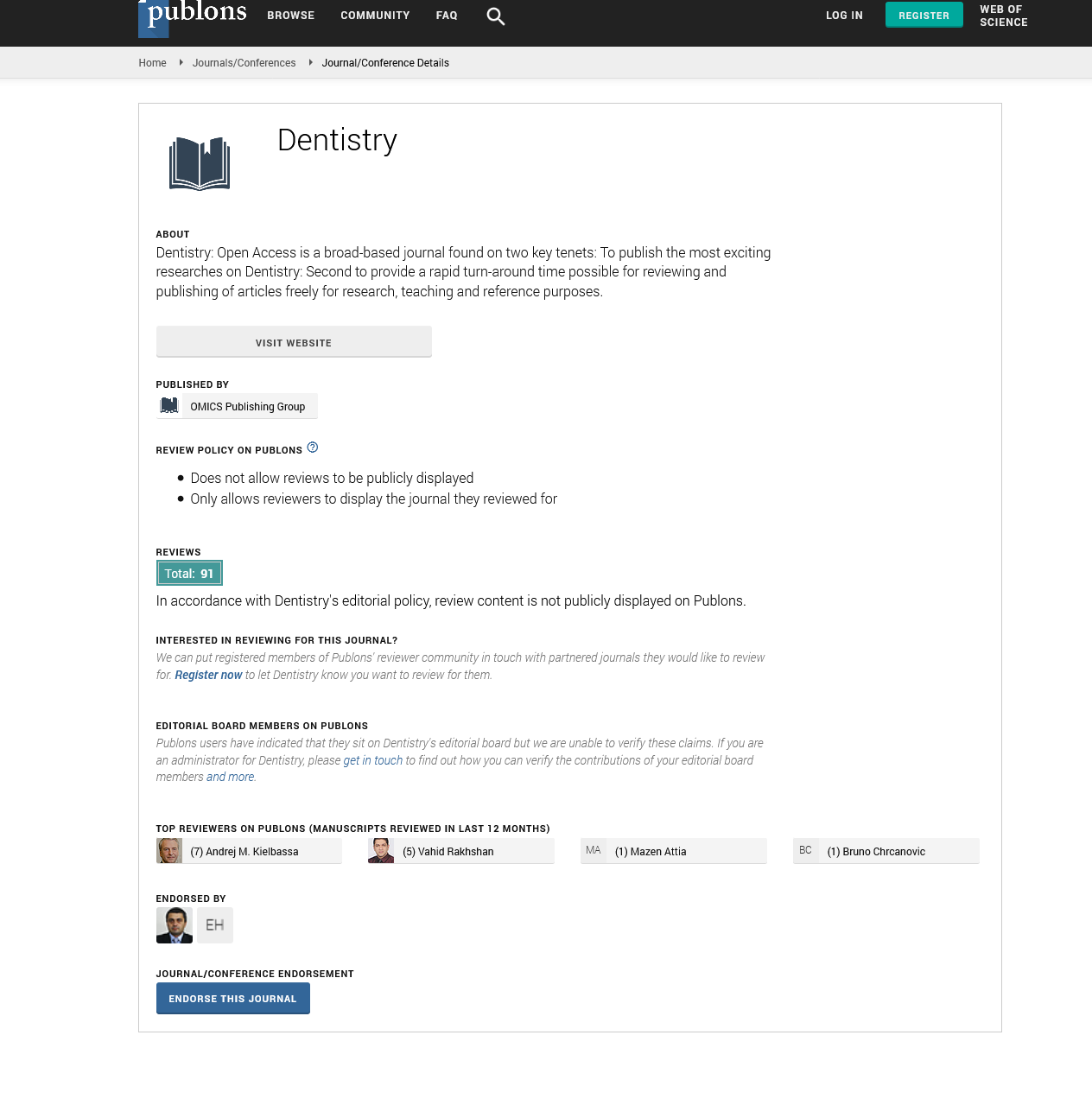Citations : 2345
Dentistry received 2345 citations as per Google Scholar report
Indexed In
- Genamics JournalSeek
- JournalTOCs
- CiteFactor
- Ulrich's Periodicals Directory
- RefSeek
- Hamdard University
- EBSCO A-Z
- Directory of Abstract Indexing for Journals
- OCLC- WorldCat
- Publons
- Geneva Foundation for Medical Education and Research
- Euro Pub
- Google Scholar
Useful Links
Share This Page
Journal Flyer

Open Access Journals
- Agri and Aquaculture
- Biochemistry
- Bioinformatics & Systems Biology
- Business & Management
- Chemistry
- Clinical Sciences
- Engineering
- Food & Nutrition
- General Science
- Genetics & Molecular Biology
- Immunology & Microbiology
- Medical Sciences
- Neuroscience & Psychology
- Nursing & Health Care
- Pharmaceutical Sciences
Opinion Article - (2024) Volume 14, Issue 4
The Impact of Material Choice on Dental Veneer Adhesion and Longevity
Kallaya Nakaparksin*Received: 25-Nov-2024, Manuscript No. DCR-24-27046; Editor assigned: 27-Nov-2024, Pre QC No. DCR-24-27046 (PQ); Reviewed: 11-Dec-2024, QC No. DCR-24-27046; Revised: 18-Dec-2024, Manuscript No. DCR-24-27046 (R); Published: 26-Dec-2024, DOI: 10.35248/2161-1122.24.14.713
Description
The aesthetic appeal of dental veneers has made them a popular choice in cosmetic dentistry. These thin layers of material are designed to cover the front surface of teeth, improving appearance and enhancing overall dental aesthetics. However, retention of veneers remains a significant challenge. This article examines the retention capabilities of dental veneers fabricated from an experimental enamel-based biopolymer compared to traditional Computer-Aided Design and Manufacturing (CAD/ CAM) hybrid materials, emphasizing the importance of material choice in ensuring long-lasting results.
Understanding dental veneers
Dental veneers are typically made from materials such as porcelain or composite resin. They serve various purposes, including correcting discoloration, repairing chips and closing gaps between teeth. The effectiveness of these veneers largely depends on their adhesion to the tooth structure, which is influenced by various factors such as material properties, surface preparation and bonding techniques.
Types of materials used
Porcelain veneers: Known for their natural appearance and stain resistance, porcelain veneers are commonly used. They require a certain level of tooth reduction for proper placement and are typically fabricated in a dental laboratory.
Composite resin veneers: These veneers are applied directly to the tooth and can be shaped and polished during the procedure. While they are more affordable, they are also less durable than porcelain.
CAD/CAM hybrid materials: This category includes materials created using computer-aided design and manufacturing technology. These veneers combine the aesthetic benefits of ceramics with the mechanical advantages of polymers, aiming to enhance both functionality and appearance.
Factors influencing retention of dental veneers
Surface preparation: Surface preparation plays a pivotal role in the retention of dental veneers. Proper cleaning, etching and priming of the tooth surface are essential for creating a suitable bonding environment. When comparing biopolymers to CAD/CAM materials, the interaction of each material with the prepared tooth surface needs to be thoroughly assessed.
Adhesive systems: The choice of adhesive significantly impacts veneer retention. Many adhesive systems are designed to bond with different types of materials, but their effectiveness can vary. An experimental enamel-based biopolymer may require a different adhesive compared to traditional ceramic materials. Evaluating the compatibility of adhesives with both material types is vital to understanding their retention capabilities.
Material properties: The mechanical and physical properties of the materials used for veneers directly influence their performance. Factors such as flexural strength, wear resistance and thermal expansion must be considered. Experimental biopolymers may exhibit unique characteristics that enhance their ability to bond with tooth enamel, whereas CAD/CAM materials might offer superior hardness and durability.
Environmental conditions: The oral environment poses several challenges to dental materials. Temperature fluctuations, moisture and exposure to various substances can affect the adhesion and longevity of veneers. Testing how experimental biopolymers perform under these conditions compared to CAD/CAM materials will provide insights into their practical applications.
Comparative analysis of retention
Experimental enamel-based biopolymers: Preliminary studies on experimental enamel-based biopolymers indicate promising adhesion to enamel surfaces. These materials exhibit properties that mimic natural tooth structure, potentially leading to enhanced retention. Their composition allows for better integration with tooth enamel, reducing the likelihood of debonding over time.
CAD/CAM hybrid materials: CAD/CAM hybrid materials have been shown to provide robust performance due to their combination of ceramic and polymer components. These materials often have high wear resistance and aesthetic qualities similar to natural teeth. However, challenges related to bonding strength and compatibility with certain adhesive systems may affect their long-term retention.
Laboratory and clinical studies: Several studies have been conducted to evaluate the retention of both material types. Laboratory tests involving shear bond strength and fatigue testing provide quantitative data on their performance. Clinical trials, although limited, are essential for understanding real- world performance. Evaluating patient outcomes, including the incidence of veneer failure, provides valuable insights into the effectiveness of each material.
Future directions
Continued research is necessary to refine the formulation of enamel-based biopolymers and assess their long-term performance in diverse clinical settings. Innovations in adhesive technologies and bonding techniques can further enhance the retention of both material types. Ultimately, the goal is to provide patients with durable, aesthetically pleasing veneers that withstand the test of time.
Final thoughts
As cosmetic dentistry evolves, understanding the properties and performance of different veneer materials remains critical. By focusing on material science and bonding strategies, dental professionals can optimize treatment outcomes, ensuring that patients enjoy the benefits of improved aesthetics and functionality in their smiles. Further studies will be vital in solidifying the role of experimental biopolymers in clinical practice and comparing their effectiveness against traditional materials.
Citation: Nakaparksin K (2024). The Impact of Material Choice on Dental Veneer Adhesion and Longevity. J Dentistry. 14:713.
Copyright: © 2024 Nakaparksin K. This is an open-access article distributed under the terms of the Creative Commons Attribution License, which permits unrestricted use, distribution, and reproduction in any medium, provided the original author and source are credited.

